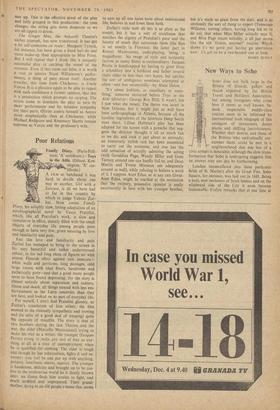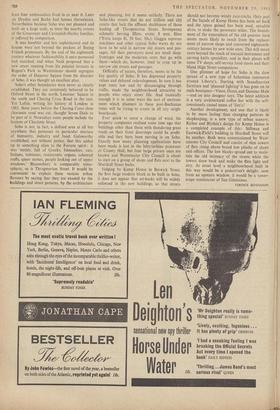New Ways to Soho
London steamrollered into these particular fields of St. Martin's after the Great Fire. Soho Square, for instance, was laid out in 1681. Being a neat, new enclosure of brick houses and on the windward side of the City it soon became fashionable. Evelyn remarks that at one time at
least four ambassadors lived in or near it. Later on Dryden and Burke had houses thereabouts. Nevertheless because Soho was not planned and built on a large scale, as were the nearby estates of the Grosvenor and Cavendish-Harley families, it suffered by comparison.
It was humbler and less sophisticated and its houses were'not beyond the pockets of fleeing French protestants. By the end of the eighteenth century whatever fashionability it once possessed had vanished, and when Nash proposed that a new street running from his palatial terraces in Regent's Park to Westminster should segregate the order of Hanover Square from the disorder of Soho, it was thought an excellent plan.
Soho's other boundaries were never as clearly established. They are commonly believed to be Oxford Street in the north, Leicester Square in the south and Charing Cross Road in the east. Yet Loftie, writing his history of London in 1883, three years before the Charing Cross slum clearance road was cut, thought Seven Dials to be part of it. Nowadays some people include the bottom of Charlotte Street.
Soho is not, in fact, a defined area at all but anywhere that, possesses its particular mixture of humanity, industry and food. Galsworthy established, not without justice, that this added up to something alien to the Forsyte spirit: it was `untidy, full of Greeks, lshmaelites, cats. Italians, tomatoes, restaurants, organs, coloured stuffs, queer names, people looking out of upper windows.' Bloomsbury is comparably atmo- spheric, so is Throgmorton Street. It would be convenient to explain these various urban flavours by saying that they are exuded by the buildings and street patterns, by the architecture and planning, but it seems unlikely. There are Soho-like streets that do not titillate and city courts that lack the affluent shabbiness of those leading off Throgmorton Street. Sevenpenny schmaltz herring fillets, erotic 8 mm. films (`Yetta keeps fit, 50 feet, 30s.); Gaggia espresso machines and other typical Soho wares do not have to be sold in narrow old streets and pas- sages. All their purveyors need are small shop- frontages and the moderate rents that go with them—which do, however, tend to crop up in narrow old streets and passages.
Difficulty of access, therefore, seems to be the key quality of Soho. It has depressed property values and delayed redevelopment. In turn it has kept rents low and by discouraging through traffic, made the neighbourhood attractive to people who enjoy street life. And ironically enough it is in some wa}4 the sort of environ- ment which planners in these post-Buchanan times will be trying to create in all city neigh- bourhoods.
Ever quick to sense a change of wind, the property companies realised some time ago that buildings other than those with thundering great roads on their front doorsteps could be profit- able and they have been moving in on Soho. Exactly how many planning applications have been made is lost in the labyrinthine processes of County Hall, but four large private ones are known and Westminster City Council is about to start on a group of shops and flats next to the Marshall Street baths.
Judging by Kemp House in Berwick Street, the first large modern block to be built in Soho, it does not appear that set-backs will be widely enforced in the new buildings, so that streets
should not become windy race-tracks. Only part of the façade of Kemp House has been set back and the space gained has been used, mirabile dictu, to make the pavement wider. The banish- ment of the atmosphere of the old quartier latin seems more likely to result from the replace- ment of narrow shops and converted eighteenth- century houses by new wide ones. This will mean rents beyond the reach of musical instrument and carving knife specialists, and in their places will come TV shops, self-service food stores and their bland High Street companions.
One glimmer of hope for Soho is the slow spread of a new type of bohemian commerce around Liberty's. Starting with Scandinavian furniture and 'planned lighting' it has gone on to male boutiques—Vince, Donikand Domino Male —and on into designer toys. The latest addition is a very architectural coffee bar with the self- consciously casual name of 'Jim's:" Another development, and one that is likely to be more lasting'. than changing patterns in shopkeeping, is a new type of urban scenery. Riches and Blythin's design for Kemp House is a completed example of this: Stillman and Eastwick-Field's building in Marshall Street will be another. Both were commissioned by West- minster City Council and consist of slim towers of flats rising above broad low plinths of shops and offices. The low blocks spread out to main- tain the old intimacy of the streets while the towers draw back and make the flats light and airy. At street level a neighbourhood built in this way would be a pedestrian's delight; seen from an upstairs window, it would be a tower- scape reminiscent of San Giminiano.
TERENCE BENDIXSON































































 Previous page
Previous page